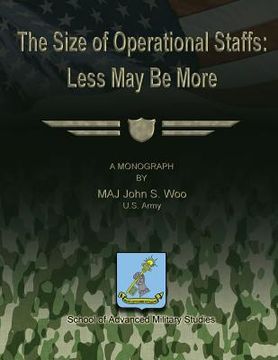Share
The Size of Operational Staffs: Less May Be More (in English)
Us Army John S. Woo
(Author)
·
School Of Advanced Military Studies
(Contributions by)
·
Createspace Independent Publishing Platform
· Paperback
The Size of Operational Staffs: Less May Be More (in English) - Studies, School Of Advanced Military ; Woo, Us Army John S.
$ 14.39
$ 17.99
You save: $ 3.60
Choose the list to add your product or create one New List
✓ Product added successfully to the Wishlist.
Go to My WishlistsIt will be shipped from our warehouse between
Monday, July 08 and
Tuesday, July 09.
You will receive it anywhere in United States between 1 and 3 business days after shipment.
Synopsis "The Size of Operational Staffs: Less May Be More (in English)"
Is there a better way to organize staffs in operational headquarters based on their roles? Following 9/11 in the ensuing Global War on Terror, the sizes of divisions and corps serving as operational headquarters have doubled and tripled, respectively. The shift to a brigade-centric army under modularity should have alleviated the burden on division and corps staffs but has instead blurred the lines of responsibility. Many senior military leaders have questioned the efficacy of such large staffs, suggesting that the resulting bureaucracy hinders decision-making and subordinate initiative. In the wake of budget cuts and impending downsizing of Department of Defense and Army personnel, the issue of restructuring for future conflicts is important. Ingrained in the American tradition of liberty and citizen-soldiers, ramping up forces and required staff to meet the challenge of new threats and then downsizing represents an American way of warfare. The modernist perspective of organization theory seeks to enhance performance through reorganizing structure and process. Contingency theory and related studies address the relationship between size and efficiency and effectiveness. Organizational design shows the advantages and disadvantages of structures (functional, project, and matrix) related to process. A study of the French and Prussian staff systems underscores the relationship between form and function. The unique roles of their staff catered to the commander and environment resulted in decidedly different staff structures but functional in nature. The additional roles of operational headquarters staffs in the U.S. Army have resulted in a matrix structure based on function. A study of the American Civil War and World War I reveals that the perception of large staffs and cyclic nature of increasing and decreasing staffs are not new. Understanding the outgrowth of this trend based on an American tradition of fearing standing armies provides a context for making changes for the future. This monograph concludes that operational staffs have indeed become too big and authorized strengths should be somewhere between 9/11 and current levels. Staff reductions should be accompanied by a clear delineation of roles and responsibilities between brigade, division, and corps staffs and reorganizing the staffs to reflect a matrix structure based on project.
- 0% (0)
- 0% (0)
- 0% (0)
- 0% (0)
- 0% (0)
All books in our catalog are Original.
The book is written in English.
The binding of this edition is Paperback.
✓ Producto agregado correctamente al carro, Ir a Pagar.

